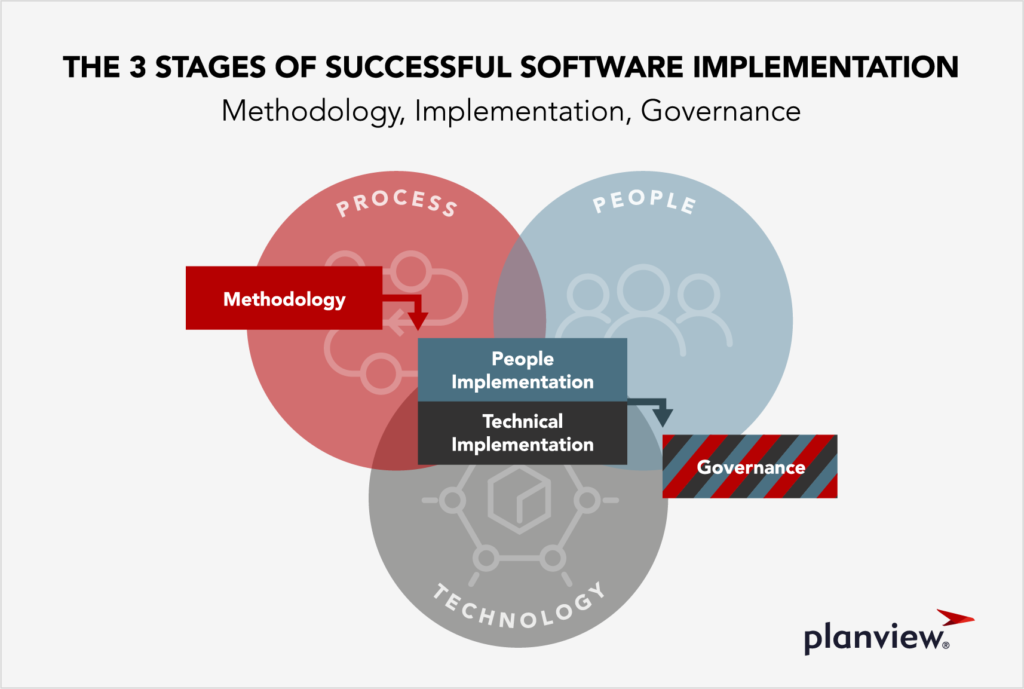
Successful software implementation requires more than buying new software and training people how to use it. Yet, all too often, organizations focus so much on standing up the solution that they lose sight of all the elements needed for success.
As a result, many fail to maximize the return on their investment in the software. More importantly, they fail to achieve the business outcomes they hoped to achieve with their implementation journey.
The best results occur when organizations view their journey as three, interdependent stages, using each stage as a foundation for the one that follows.
Over the years, I have seen many successful software implementations – and quite a few that were not – and have since defined must-haves for implementing new software across an organization.
3 Stages of Successful Software Implementation
First things first: A platform intended for the organization poses an organizational challenge. It requires the organization’s attention to achieve success.
This may seem obvious, but you would be surprised how many organizations embark on implementations without being well prepared for them to land successfully.
It is important to keep this organizational state of mind throughout your software implementation, as it should dictate your approach: Such an implementation calls for an organizational approach, definitions, and decisions. There are three stages that you must consider, plan for, and execute: methodology, implementation, and governance.

These stages complement the well-known People-Process-Technology triangle and help explain how to execute a successful software implementation.
Not planning for (and not executing) all three of these stages may enable you in the short term, but the results will not be sustainable or scalable.
Missing any one of these foundational stages will destabilize your operation and prevent the following stage from providing its expected result, since the stages should be executed sequentially.
1. Methodology
An organizational approach to executing a practice or a process – whether a common one, like planning, or a more bespoke business process – needs to be paired with an organizational state of mind. A process not well defined will be left in the void. It will either be practiced flexibly, according to different staff members’ own interpretations, or simply avoided.
Let’s take a simple process as an example: A portfolio manager expects his project managers to identify and manage their project risks and to escalate the critical ones. This expectation is known to all. It is a good starting point, but leaving it there will result only in sporadic, non-standard adherence. In some cases, the expected actions will not happen at all, because the expectation was not made clear enough.
Any technological solution that was implemented to support the project managers and handle risk management in this example, will not provide the anticipated value or make the desired impact. Additionally, the portfolio manager’s expectations will most likely be met sub-optimally, or simply unattended to.
Disappointing outcomes can be traced back, in large part, to a lack of methodology for the practice that the software was implemented for. The methodology can be simple and basic, or it can be elaborate and advanced, but a methodology must be defined.
The methodology’s definition should cover the minimum that will gain you the level of standard practice you are looking to achieve. You can leave space for teams to be flexible and to tailor the methodology to fit their varying levels of maturity, as well as individuals’ personal experience and skills, and company culture.
Visible symptoms if skipped: If the Methodology stage is skipped, you are most likely to see low adherence to expectations, no standardization, low adoption of the software, and high likelihood of not achieving the expected business outcomes.
2. Implementation
Your implementation is your organizational approach to bringing your methodology to life, by addressing both the people and the technology involved in the initiative.
This includes applying the required changes and setups to your technological solutions to match your methodology and applying organization change management practices to address the “people challenge.” It should include plans to address the expected organizational change, such as building awareness, motivation, communications, etc. to cover the updated methods and processes, along with the new supporting technological solution.
Let’s continue with the previous example of risk management and escalation: If there was no methodology defined, then what would you implement? This step dictates you complete the first stage first. But even then, the people challenge needs to be addressed. You will need to assign a change manager to drive the behavioral and cultural change.
Visible symptoms if skipped: If the Implementation stage is skipped, you are most likely to see low adherence to expectations, no standardization, low adoption of the software, and high likelihood of missing the expected outcomes
3. Governance
Governance is an organizational approach to verify the Implementation is carried out and sticks as a regular operation.
It defines how various stakeholders in the organization must practice a cadence that verifies the People adherence to the defined Methodology, utilizing the defined Technology, and achieve the desired outcomes. It is a key part in the long-term success of your implementation, and in my observation, very frequently neglected, to the extent that undermines all the efforts that were made prior.
Governance is commonly practiced to keep track of results. But focusing only on results, and not understanding how people are following (or not following) the process, will not allow you to identify gaps in your process and/or adherence to it, and will make it harder for you to ever improve the process, let alone your business outcomes.
You can have governance without first defining the methodology or investing in implementation; however, that approach only weakens your results.
Practicing governance without proper methodology and proper implementation demands high overhead week after week, relying heavily on specific individuals. When those individuals are absent or leave the company, there will be nothing left of what they have established, as none of governance is built into the organization’s DNA.
Visible symptoms if skipped: If the Governance stage is skipped, you are most likely to experience high staff overhead, high staff/PMO fatigue, tracking results and neglecting process, focusing on data collection and data updates, rather than focusing on managing based on reported data, and low adoption of software.
Evolve in Your Software Implementation
The good news is that a less-than-ideal start to a software implementation does not have to be terminal. It can be turned around quickly, in fact. Remarkably similar symptoms will be apparent, regardless of the root cause – low adoption, high overhead, and not meeting the objectives.
Inspecting each of your practice areas, and delving into how well they were staged, will quickly reveal the stage that poses a gap.
Determining if your methodology is well defined, how well the practice areas were implemented, and how they are governed will inform the way forward for rescuing your investment and turning it into a successful software implementation.
Up-level and transform your organization
Planview’s Evolve Advisory Services is a team of experienced practitioners who have been in your shoes. This group of industry experts will partner with you, get to know your business, and apply their knowledge of best practices to help you achieve your business goals and realize your strategy, enabling the change that powers growth.
If you are a Planview customer interested in partnering with the Evolve team, then contact your Planview representative to get started.




